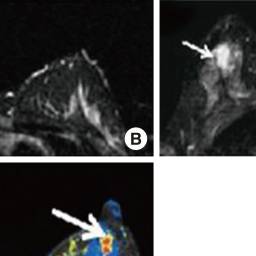Magnetic Resonance Imaging Features of Adenosis in the Breast (vol 18, pg 187, 2015)
In this study, we aim to describe the features of breast adenosis lesions with suspicious or borderline findings on dynamic contrast-enhanced magnetic resonance imaging (DCE-MRI)

Purpose
Adenosis lesions of the breast, including sclerosing adenosis and adenosis tumors, are a group of benign proliferative disorders that may mimic the features of malignancy on imaging. In this study, we aim to describe the features of breast adenosis lesions with suspicious or borderline findings on dynamic contrast-enhanced magnetic resonance imaging (DCE-MRI).
Methods
In our database, we identified 49 pathologically proven breast adenosis lesions for which the final assessment of the breast MRI report was classified as either category 4 (n=45) or category 5 (n=4), according to the Breast Imaging Reporting and Data System (BI-RADS) published by the American College of Radiology (ACR). The lesions had a final diagnosis of either pure adenosis (n=33, 67.3%) or mixed adenosis associated with other benign pathologies (n=16, 32.7%).
Results
Of the 49 adenosis lesions detected on DCE-MRI, 32 (65.3%) appeared as enhancing masses, 16 (32.7%) as nonmass enhancements, and one (2.1%) as a tiny enhancing focus. Analysis of the enhancing masses based on the ACR BI-RADS lexicon revealed that among the mass descriptors, the most common features were irregular shape in 12 (37.5%), noncircumscribed margin in 20 (62.5%), heterogeneous internal pattern in 16 (50.0%), rapid initial enhancement in 32 (100.0%), and wash-out delayed en-hancement pattern in 21 (65.6%). Of the 16 nonmass enhancing lesions, the most common descriptors included focal distribution in seven (43.8%), segmental distribution in six (37.5%), clumped internal pattern in nine (56.3%), rapid initial enhancement in 16 (100.0%), and wash-out delayed enhancement pattern in eight (50.0%).
Conclusion
Adenosis lesions of the breast may appear suspicious on breast MRI. Awareness of these suspi-cious-appearing features would be helpful in obviating unnecessary breast biopsies.







ارسال به دوستان